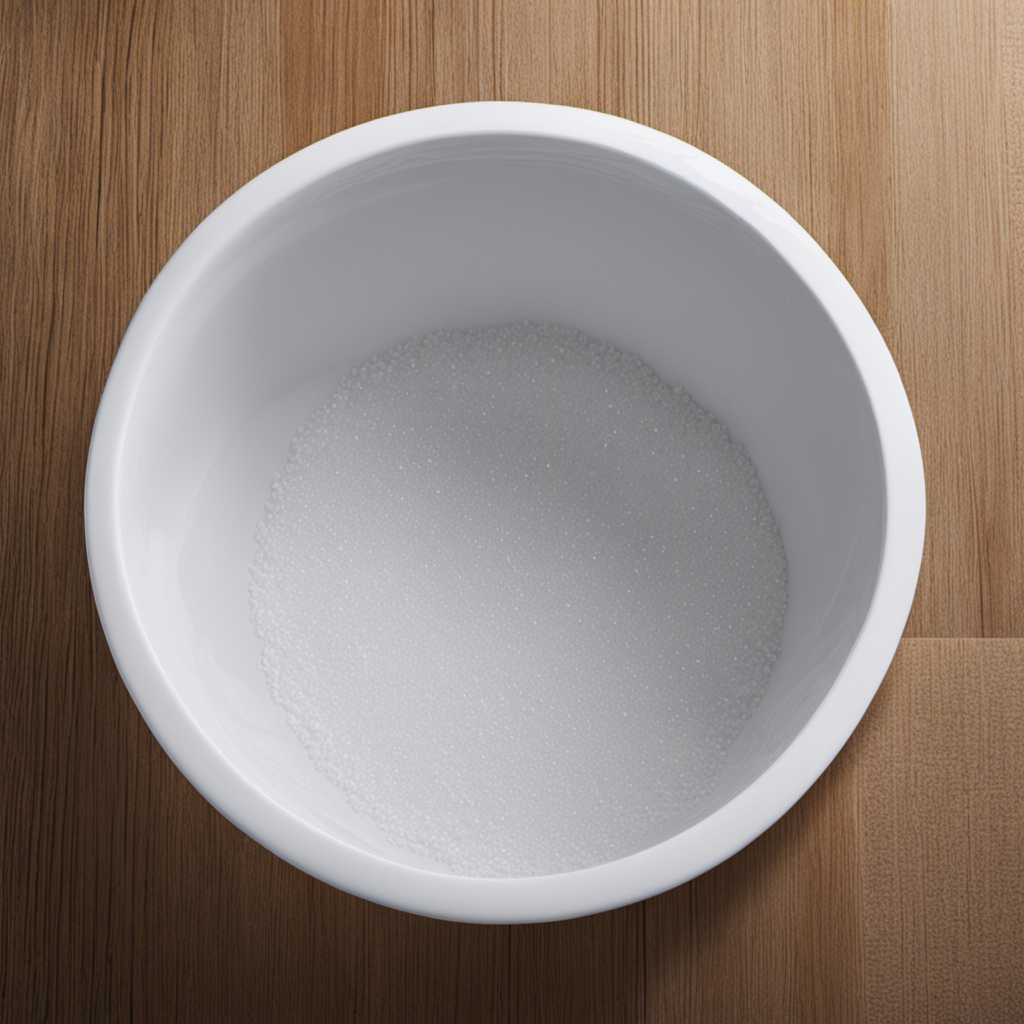I step into the bathroom and gaze at my bathtub, its once pristine surface now marred with dirt and grime. But fear not, for I have the solution to restore its former glory.
In this step-by-step guide, I will show you how to clean your bathtub with ease. From identifying the material of your tub to gathering the necessary supplies, we will tackle every stain and banish every speck of soap scum.
Get ready to transform your bathtub into a sparkling oasis of cleanliness.
Key Takeaways
- There are different types of bathtub materials including acrylic, porcelain, fiberglass, and enamel, each requiring specific cleaning techniques.
- Essential cleaning supplies for cleaning a bathtub include white vinegar, baking soda, a spray bottle, a sponge or cloth, and a microfiber cloth.
- Before cleaning the bathtub, gather all the necessary supplies, remove bath mats and accessories, rinse the tub with warm water, and spray vinegar onto the tub surface.
- To clean tough stains, apply a baking soda paste, gently scrub the entire tub, let the paste sit for a few minutes, and then rinse the tub thoroughly.
Types of Bathtub Materials
If you’re looking to clean your bathtub, it’s important to know the different types of bathtub materials. Understanding the material of your bathtub is crucial because it determines the cleaning techniques you should use. There are various bathtub materials available, including acrylic, porcelain, fiberglass, and enamel.
To clean an acrylic bathtub, start by rinsing it with warm water to remove any loose dirt or debris. Then, mix a solution of warm water and mild dish soap. Use a soft cloth or sponge to gently scrub the bathtub, making sure to avoid any abrasive cleaners or scrub brushes that could scratch the surface. Rinse thoroughly and dry with a clean towel.
Porcelain bathtubs require a different approach. Create a paste by mixing baking soda and water. Apply the paste to the bathtub and let it sit for a few minutes. Then, use a brush or sponge to scrub the surface in circular motions. Rinse thoroughly and wipe dry.
For fiberglass bathtubs, use a non-abrasive cleaner specifically designed for fiberglass surfaces. Apply the cleaner and let it sit for a few minutes. Then, use a soft cloth or sponge to gently scrub the bathtub. Rinse thoroughly and dry.
Finally, enamel bathtubs can be cleaned by mixing equal parts of white vinegar and warm water. Apply the solution to the bathtub and let it sit for a few minutes. Then, use a soft cloth or sponge to scrub the surface. Rinse thoroughly and dry with a clean towel.
Knowing the proper cleaning techniques for your specific bathtub material is essential to maintain its cleanliness and longevity.
Essential Cleaning Supplies
To get started, you’ll need some essential cleaning supplies for your tub.
Here’s a step-by-step guide on what you’ll need and how to use them effectively.
First, gather white vinegar, baking soda, a sponge or cloth, and a spray bottle.
Mix equal parts vinegar and water in the spray bottle.
Spray the solution onto the rust stains and let it sit for a few minutes.
Next, sprinkle baking soda onto the stains and scrub gently with a sponge or cloth.
Rinse the tub thoroughly with warm water.
For hard water stains, soak a cloth in vinegar and place it on the affected areas for 15-20 minutes.
Scrub gently and rinse.
Repeat if necessary.
With these essential cleaning supplies, you can keep your tub clean and free from rust and hard water stains.
Preparing the Bathtub for Cleaning
Before you start, make sure you have the necessary supplies ready for preparing the tub. To begin, gather a pair of rubber gloves, a scrub brush or sponge, a microfiber cloth, white vinegar, baking soda, and a spray bottle. These items will help you achieve a sparkling clean bathtub without the use of harsh chemicals.
Start by removing any bath mats or accessories from the tub. Next, rinse the tub with warm water to remove any loose debris. Then, spray a generous amount of white vinegar onto the tub surface, focusing on areas with soap scum or stains. Let the vinegar sit for a few minutes to loosen the dirt.
Meanwhile, create a paste using baking soda and water, and apply it to any tough stains or grime. Use the scrub brush or sponge to gently scrub the entire tub, paying extra attention to problem areas. Rinse the tub thoroughly with warm water, making sure to remove all traces of vinegar and baking soda.
Scrubbing and Removing Stains
Start by applying the baking soda paste to any tough stains or grime, using the scrub brush or sponge to gently scrub the entire tub. Baking soda is a natural cleaning solution that is effective at removing hard water stains. It acts as a gentle abrasive that helps to break down and lift away the stains.
To make the paste, simply mix baking soda with a small amount of water until you have a thick, spreadable consistency. Once applied, let the paste sit on the stains for a few minutes to allow it to work its magic. Then, use the scrub brush or sponge to scrub the stains in a circular motion, applying gentle pressure.
Rinse the tub thoroughly with water to remove any residue. Now that the tough stains are removed, let’s move on to tackling grime and soap scum.
Tackling Grime and Soap Scum
When it comes to tackling grime and soap scum in the bathroom, there are a few effective cleaning methods that I have found to work well.
First, I start by mixing equal parts of white vinegar and water in a spray bottle. I then spray this mixture onto the surfaces that are affected by grime and soap scum, and let it sit for a few minutes before scrubbing with a sponge or brush.
To prevent future build-up, I make sure to regularly wipe down the surfaces with a microfiber cloth after each use and use a squeegee to remove excess water from the shower walls.
Effective Cleaning Methods
To effectively clean your bathtub, you’ll want to mix together a solution of vinegar and baking soda. This powerful combination is not only effective in removing dirt and grime, but it’s also a natural cleaning solution that is safe for you and the environment.
First, start by sprinkling baking soda all over the surface of the tub. Then, pour vinegar over the baking soda and let the mixture fizz and bubble. This reaction helps to break down soap scum and other tough stains.
Next, take a scrub brush or sponge and scrub the entire surface of the tub. Pay special attention to areas with stubborn stains or buildup. Rinse the tub thoroughly with warm water to remove any residue.
For deep cleaning, you can also use a paste made of baking soda and water. Apply the paste to the areas that need extra attention and let it sit for a few minutes before scrubbing and rinsing.
Preventing Future Build-Up?
To prevent future build-up, make sure to wipe down the surfaces of your tub regularly after each use. This simple step can go a long way in preventing mold growth and removing hard water stains.
After each use, grab a clean cloth or sponge and give the tub a quick wipe down. Pay special attention to the areas where water tends to accumulate, such as the corners and edges.
If you notice any soap scum or hard water stains, use a mild cleaner or a mixture of vinegar and water to gently scrub away the buildup. Rinse thoroughly and dry the tub with a towel to prevent any moisture from lingering.
Maintaining a Clean Bathtub
To maintain a clean bathtub, it is important to address two key points: preventing soap scum buildup and using effective cleaning products.
First, to prevent soap scum buildup, I make it a habit to wipe down the bathtub after each use with a microfiber cloth. This helps remove any soap residue and prevents it from hardening and turning into stubborn scum.
Secondly, when it comes to cleaning products, I find that using a combination of baking soda and vinegar works wonders. I sprinkle baking soda on the bathtub surface, then spray it with vinegar, allowing it to fizz and loosen any grime.
Preventing Soap Scum Buildup
You can easily prevent soap scum buildup by wiping down your bathtub after each use. This simple habit will help keep your tub clean and free from unsightly stains.
Here are some best cleaning techniques to prevent soap scum buildup:
-
Use a squeegee or a microfiber cloth to wipe the tub surface after each use. This will remove any soap residue before it has a chance to harden and form scum.
-
Regularly clean your bathtub with a mild detergent or a vinegar and water solution. This will help dissolve any existing soap scum and prevent future buildup.
-
Consider using a shower cleaner or a daily shower spray that is specifically designed to prevent soap scum. These products can be applied after each use to keep your tub sparkling clean.
Effective Cleaning Products
Now that we know how to prevent soap scum buildup in our bathtubs, let’s move on to the next step: finding effective cleaning products.
There are many powerful cleaners available on the market that can tackle tough stains and grime. However, if you prefer natural alternatives, there are plenty of options as well.
One natural alternative is vinegar. Its acidic properties can help dissolve soap scum and mineral deposits. Simply mix equal parts vinegar and water in a spray bottle, spray the solution onto the surface of your bathtub, and let it sit for a few minutes. Then, scrub the area with a sponge or brush and rinse thoroughly.
Another natural option is baking soda. Its abrasive nature makes it great for scrubbing away stains. Create a paste by mixing baking soda with a little water, then apply it to the bathtub. Use a sponge or brush to scrub the surface, then rinse clean.
Frequently Asked Questions
How Often Should I Clean My Bathtub?
I clean my bathtub regularly to keep it hygienic and free of soap scum. I find that using the best bathtub cleaning products helps remove stubborn residue effectively.
Can I Use Bleach to Clean My Bathtub?
Yes, you can use bleach to clean a bathtub, but there are also bleach alternatives like vinegar that work just as effectively. Let me guide you through the step-by-step process of cleaning your bathtub using these methods.
Can I Use a Scrub Brush to Clean My Bathtub?
Yes, using a scrub brush is a great way to clean a bathtub. However, there are alternatives such as a sponge or a microfiber cloth. The best cleaning products for bathtubs include vinegar, baking soda, and mild dish soap.
How Can I Remove Hard Water Stains From My Bathtub?
To prevent hard water stains in a bathtub, I use vinegar and baking soda as my go-to cleaning products. They work wonders in removing those stubborn stains, leaving my bathtub sparkling clean.
Are There Any Natural Alternatives to Commercial Cleaning Products for Cleaning a Bathtub?
There are natural cleaning solutions available for cleaning a bathtub. You can make your own DIY bathtub cleaners using ingredients like vinegar, baking soda, and lemon juice. They are effective and eco-friendly alternatives to commercial cleaning products.
Conclusion
In conclusion, keeping a clean bathtub is essential for maintaining a hygienic and relaxing bathroom environment. By following the step-by-step guide provided, you can easily remove stains, grime, and soap scum from your bathtub.
Remember to choose the appropriate cleaning supplies based on the material of your tub and regularly maintain its cleanliness. As the saying goes, a clean bathtub is like a refreshing oasis, offering a peaceful escape from the chaos of the world.
So, roll up your sleeves and get ready to enjoy a sparkling clean tub!










